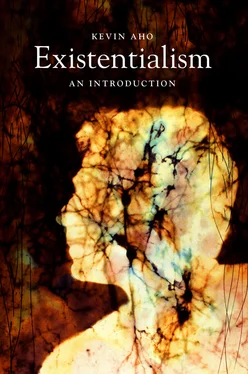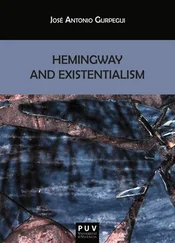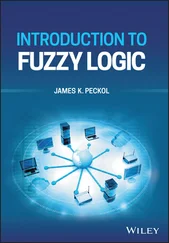In other words, although it may be an objective fact that my computer weighs a certain number of pounds, this is not how I encounter it in everyday life. It is not a brute object ‘present-at-hand’ ( vorhanden ); it is ‘ready-to-hand’ ( zuhanden ), an available and functional tool that already means something to me because it is bound up with the purposive activities, projects, and equipment that constitute my identity as a professor. The computer matters to me, in this case, because I use it to communicate with students, to do research, to contact journal and book editors, and to compose manuscripts that I hope will be published one day, and these activities are ultimately performed in an effort to fill out my self-interpretation as a responsible, hard-working professor. What this reveals is that the fact — value distinction is itself derived from a more basic way of being in which we are bound up in shared contexts of meaning, and in these contexts fact and value are inseparable. We can unpack this account in more detail by turning to Heidegger's famous account of the ‘work-world’ ( Werkwelt ) in Being and Time .
In section 15 of Being and Time , Heidegger offers an example of hammering in the workshop to show that the hammer makes sense only in relation to other things, to nails, boards, gloves, and to purposive human activities such as building a cabinet or framing a door. This means that the equipment that we use in ordinary situations is never understood in isolation. “Taken strictly,” says Heidegger, “there ‘is’ no such thing as an equipment” (1962, 97). Equipment is meaningful only in relation to a practical context, and it is because we are already familiar with the context as a whole that the hammer can reveal itself to me as a hammer. With the workshop analogy, Heidegger is suggesting that when we use things in ordinary situations, we already embody an understanding of equipment, and this understanding is constituted not by staring at it from a standpoint of detachment, but by “seizing hold of it” (98), that is, by manipulating, handling, and using it. Indeed, in these kinds of situations mental reflection actually gets in the way of how we use and handle things. It is for this reason that Heidegger uses the word ‘comportment’ ( Verhalten ) to refer to ordinary human practices, because the word does not carry with it any mentalistic undertones (Dreyfus 1991, 50–51).
I do not, for instance, first reflect on the physical properties of the doorknob before I open the door. In the flow of my daily life, I simply reach out and open the door. In doing so, the objective, thing-like properties of the door “withdraw” or disappear (Heidegger 1962, 99). In fact, it is usually only when there is a breakdown in the flow of my workaday activities — when, for instance, the door does not open when I turn the knob — that the door becomes ‘unworldly’ ( enweltlich ), that is, it is pulled out of its relational context and obtrudes as an object. In these experiences of breakdown, the unusable door “just sits there; it shows itself as an equipmental thing which looks so and so, and which, in its readiness-to-hand as looking that way, has constantly been present-at-hand” (103). To think, then, that the mind is forever mediating our ordinary dealings with things is, for Heidegger, “an absurdity which misconstrues the basic ontological structure of the being that we ourselves are” (1982, 64). When things are functioning smoothly, we are not explicitly conscious or aware of the equipment we are using because we are already absorbed in the activity and in the meaningful context as a whole, and it is through this activity that our understanding of equipment is revealed. The act of opening the door, then, requires a pre-reflective understanding of a whole ‘referential totality,’ the purposive interconnection of hallways, lights, knobs, stairs, and so on that allows the door to reveal itself as a door. The upshot of this view is that intra-worldly things are organized and structured by the ways in which they relate to other things, and it is our involvement in this context that reveals how they make sense and matter to us in the ways that they do.
Here we can see how Heidegger's interpretation of the world as a unified context of meanings not only challenges the scientific view of the world as a spatiotemporal container or the sum total of objects; it also undermines the naturalistic assumption that the value of things is merely the subjective projection of our own individual tastes. For Heidegger, things already matter to us because they are expressions of the shared meanings we are engaged in. When I sit down at the table, for example, I do not initially encounter a flat, rectangular, or box-shaped object, I encounter something that matters to me and is already embedded in a web of social meanings. It is “a writing table, a dining table… [The table where] the boys like to busy themselves … [The table where] that decision was made with a friend that time, where that work was written that time, where that holiday was celebrated that time” (Heidegger 1999a, 69). Merleau-Ponty will develop Heidegger's account of engaged and situated meaning, but instead of the equipmental relations of the work-world, he begins from the perceptions of the lived body.
In Phenomenology of Perception , Merleau-Ponty describes his project as a “return to the world of actual experience that is prior to the objective world” (1962, 45). Like Heidegger, he is critical of the standpoint of theoretical detachment because it tends to reduce the world to a spatiotemporal container and regards things not in terms of their mutual interdependence but as “ partes extra partes ” (73), as objects in a purely mechanical and external relationship with other objects. The world, for Merleau-Ponty, is not a geometric space or the sum total of objects. It is, rather, a “phenomenal field” (57), understood as the concrete background or setting in which we exist. The use of the word ‘field’ is important because it conveys the sense of the region or space of concern that we are involved in — like the field that we play soccer on — rather than something that is spread out below us (Langer 1989, 19). For Merleau-Ponty, it is the primacy of our situated perceptual involvements that makes it possible for us to adopt a scientific view of things in the first place. This is why he refers to being-in-the-world as a return to that world “which precedes [scientific] knowledge, of which knowledge always speaks, and in relation to which every scientific schematization is an abstract and derivative sign language” (1962, ix).
Where Merleau-Ponty differs from Heidegger is in the way he accesses the phenomenon of being-in-the-world. Heidegger focuses largely on ‘handiness’ and the relational projects of the work-world, whereas Merleau-Ponty focuses on the world of perception as the unified background that situates and orients our projects (Wrathall 2009, 38). This is why there is a ‘primacy of perception,’ for Merleau-Ponty, because what we first experience and what underlies all theoretical reflection is the world — as it is perceived . He refers to the perceived world “as the always presupposed foundation of all rationality, all value and all existence” (1964a, 13). Here the word ‘perception’ is obviously not being used in the way that it is ordinarily understood. It is not an atomistic collection of sensations that are constituted or linked together by some mental process. What we perceive, rather, is a structured and unified whole, where “the perceptual ‘something’ is always in the middle of something else, it always forms part of a ‘field’ ” (1962, 4). This means that there is no such thing as an isolated or ‘pure impression.’ Sensations make sense only insofar as they relate to other sensations in this unified whole.
Читать дальше












